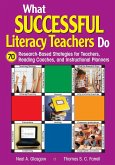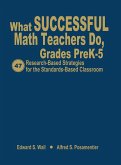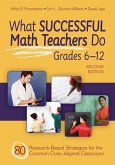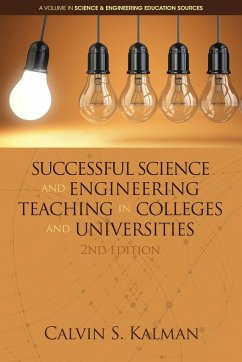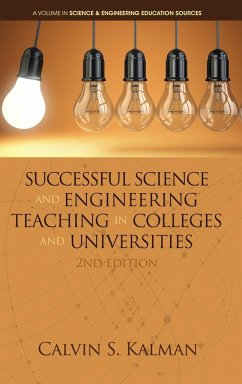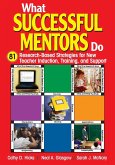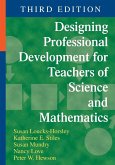Neal A. Glasgow, Michele Cheyne, Randy K. Yerrick
What Successful Science Teachers Do
75 Research-Based Strategies
Neal A. Glasgow, Michele Cheyne, Randy K. Yerrick
What Successful Science Teachers Do
75 Research-Based Strategies
- Broschiertes Buch
- Merkliste
- Auf die Merkliste
- Bewerten Bewerten
- Teilen
- Produkt teilen
- Produkterinnerung
- Produkterinnerung
Supercharge your science lessons with proven strategies! The experience and science expertise of these award-winning authors makes this easy-to-use guide a teacher's treasure trove. Included are 75 research-based strategies, each with a concise description of the supporting research, classroom applications, pitfalls to avoid, and references for additional learning. Teachers of students in Grades K-12 will find novel ways to engage children's natural curiosity, concern, and creativity. Highlights include how to: Promote collaborative learning Differentiate instruction with culturally responsive…mehr
Andere Kunden interessierten sich auch für
![What Successful Literacy Teachers Do What Successful Literacy Teachers Do]() Neal A. GlasgowWhat Successful Literacy Teachers Do39,99 €
Neal A. GlasgowWhat Successful Literacy Teachers Do39,99 €![What Successful Math Teachers Do, Grades Prek-5 What Successful Math Teachers Do, Grades Prek-5]() Alfred S. PosamentierWhat Successful Math Teachers Do, Grades Prek-575,99 €
Alfred S. PosamentierWhat Successful Math Teachers Do, Grades Prek-575,99 €![What Successful Math Teachers Do, Grades 6-12 What Successful Math Teachers Do, Grades 6-12]() Alfred S. PosamentierWhat Successful Math Teachers Do, Grades 6-1239,99 €
Alfred S. PosamentierWhat Successful Math Teachers Do, Grades 6-1239,99 €![Successful Science and Engineering Teaching in Colleges and Universities, 2nd Edition Successful Science and Engineering Teaching in Colleges and Universities, 2nd Edition]() Calvin S. KalmanSuccessful Science and Engineering Teaching in Colleges and Universities, 2nd Edition61,99 €
Calvin S. KalmanSuccessful Science and Engineering Teaching in Colleges and Universities, 2nd Edition61,99 €![Successful Science and Engineering Teaching in Colleges and Universities, 2nd Edition (hc) Successful Science and Engineering Teaching in Colleges and Universities, 2nd Edition (hc)]() Calvin S KalmanSuccessful Science and Engineering Teaching in Colleges and Universities, 2nd Edition (hc)105,99 €
Calvin S KalmanSuccessful Science and Engineering Teaching in Colleges and Universities, 2nd Edition (hc)105,99 €![What Successful Mentors Do What Successful Mentors Do]() Cathy D. HicksWhat Successful Mentors Do39,99 €
Cathy D. HicksWhat Successful Mentors Do39,99 €![Designing Professional Development for Teachers of Science and Mathematics Designing Professional Development for Teachers of Science and Mathematics]() Katherine E StilesDesigning Professional Development for Teachers of Science and Mathematics45,99 €
Katherine E StilesDesigning Professional Development for Teachers of Science and Mathematics45,99 €-
-
-
Supercharge your science lessons with proven strategies! The experience and science expertise of these award-winning authors makes this easy-to-use guide a teacher's treasure trove. Included are 75 research-based strategies, each with a concise description of the supporting research, classroom applications, pitfalls to avoid, and references for additional learning. Teachers of students in Grades K-12 will find novel ways to engage children's natural curiosity, concern, and creativity. Highlights include how to: Promote collaborative learning Differentiate instruction with culturally responsive practices Build students' scientific literacy and reasoning skills Involve parents in their children's science learning
Hinweis: Dieser Artikel kann nur an eine deutsche Lieferadresse ausgeliefert werden.
Hinweis: Dieser Artikel kann nur an eine deutsche Lieferadresse ausgeliefert werden.
Produktdetails
- Produktdetails
- Verlag: Corwin
- Artikelnr. des Verlages: B72338P
- Seitenzahl: 272
- Erscheinungstermin: 20. September 2010
- Englisch
- Abmessung: 254mm x 178mm x 15mm
- Gewicht: 518g
- ISBN-13: 9781412972345
- ISBN-10: 1412972345
- Artikelnr.: 30150926
- Verlag: Corwin
- Artikelnr. des Verlages: B72338P
- Seitenzahl: 272
- Erscheinungstermin: 20. September 2010
- Englisch
- Abmessung: 254mm x 178mm x 15mm
- Gewicht: 518g
- ISBN-13: 9781412972345
- ISBN-10: 1412972345
- Artikelnr.: 30150926
Neal A. Glasgow¿s experience includes serving as a secondary school science and art teacher both in California and New York, as a university biotechnology teaching laboratory director and laboratory technician, and as an educational consultant and frequent speaker on many educational topics. He is the author or coauthor of ten books on educational topics: What Successful Schools Do to Involve Families: Fifty Research-Based Strategies for Teachers and Administrators (2008), What Successful Literacy Teachers Do: 70 Research-Based Strategies for Teachers, Reading Coaches, and Instructional Planners (2007), What Successful Teachers Do in Diverse Classrooms: 71 Research-Based Strategies for New and Veteran Teachers (2006); What Successful Teachers Do in Inclusive Classrooms: 60 Research-Based Strategies That Help Special Learners (2005); What Successful Mentors Do: 81 Researched-Based Strategies for New Teacher Induction, Training, and Support (2004); What Successful Teachers Do: 91 Research-Based Strategies for New and Veteran Teachers (2003); Tips for Science Teachers: Research-Based Strategies to Help Students Learn (2001); New Curriculum for New Times: A Guide to Student-Centered, Problem-Based Learning (1997); Doing Science: Innovative Curriculum Beyond the Textbook for the Life Sciences (1997); and Taking the Classroom to the Community: A Guidebook (1996).
Foreword by Page Keeley Preface Acknowledgments About the Authors Introduction 1. General Science Instruction Encourage Students to Become More Involved and Interested in Science Guide Students to Engage in Science-Appropriate Discourse Utilize Graphic Organizers in Your Classroom Increase Depth of Coverage to Improve Student Learning Foster Self-Efficacy and Motivation in Your Students Challenge Your Students With Different Levels of Questioning Try Using the 5E Instructional Model Support Your Students to Engage Effectively in Disciplinary Argumentation Utilize Mind Mapping to Improve Student Achievement Test Students
Ideas to Facilitate Reasoning Skills Create an Emotionally Positive Science Classroom Environment Engage Students Who Have a History of Poor School Achievement Include Students With Special Needs in Student-Centered Instruction 2. Scientific Inquiry and Laboratory Experience Engage Your Students in Inquiry-Based Science Teach Model-Based Inquiry Over the Scientific Method Use Problem-Based Learning to Introduce Students to Inquiry-Based Science Implement Inquiry-Based Instruction in Low-Track Classes Attain Educational Goals Through Laboratory Experiences Convert Traditional Labs to Inquiry-Based Activities Align the Goals of Dissection to the Curriculum 3. Collaborative Teaching and Learning Fine-Tune Collaborative Student Relationships With the Socratic Seminar Teach Your Students Collaborative Strategies and Skills Utilize Formal Cooperative Learning Methods in the Classroom Introduce Students to Constructive, Cooperative, and Academic Controversy Communicate Beyond the Classroom by Using Electronic Pen Pals 4. Utilizing Technology for the Classroom and Professional Development Add Technological Tools to Your Students
Learning Put Your Students
Internet Skills to Use in the Classroom Use Technology to Accommodate Students
Different Learning Styles Give Students Opportunities to Use Media Production for Classwork Incorporate Mobile Technology into Student Assignments Model Inquiry With Students Using Limited Resources Update Your Approach to Literacy-Related Content Activities Foster Literacy Development Through Visual Texts and Media Utilize Portable Media Players to Bring Exemplary Resources Into Teaching Find Opportunities to Record Yourself Teaching to Share With Peers 5. Science Assessment Look at Formative Assessment in a Coherent and Cohesive Way Use Standards-Based Inquiry to Prepare Students for Standards-Based Tests Align Instruction and Assessment Tools to State Curriculum Standards Utilize Formative Assessment to Better Engage Students in Content and Instruction Add a Classroom Response System for Instant Formative Assessment Design Formative Assessment for Data to Inform Instruction Encourage Assigned Textbook Reading by Giving Open-Book Tests Focus on Students
Writing Strengths 6. Culturally Responsive Teaching and Learning Avoid Culturally Stereotyping Science Students Make Academic Success Your First Priority for All Students Reach Out to Students From Unfamiliar Cultural and Linguistic Backgrounds Structure Homework for Success for Students From Nondominant Backgrounds Develop Science Standards With a Multicultural Perspective Broaden Discourse Opportunities to Invite a Diverse Range of Contributions Provide Diverse Learning Opportunities for Student Discourse Manage and Change Your Students
Misconceptions Guide Students to Choose Authentic Problems to Solve Utilize Meaningful Cues With Your English Language Learners Provide ELLs With Opportunities for Extended Interactions in Group Work 7. The Complex Nature of the Gender Gap in Science Examine the Evolving Nature of Gender Issues in Science Classrooms Change the Opportunities and Experiences of Girls in the Science Classroom Represent Science in Ways That Encourage Girls to Stay Interested Improve Attitudes Toward Science Through STS Approaches 8. Science and Literacy Address the Three Key Elements of Reading Fluency in Science Instruction Use Scaffolding to Improve Science Reading Comprehension Consider Reading as Inquiry With Primary Literature Focus on Developing Scientific Literacy and Student Reasoning Use Paraphrasing to Promote Reading Comprehension in Science Textbooks Utilize Think-Alouds to Reveal Students
Thought Processes While Reading Select Commercial Reading Programs That Can Improve Scientific Literacy Use a Variety of Print Materials to Inspire Student Reading and Writing Expand Vocabulary Instruction to Improve Comprehension and Motivation Use Students
Native Languages in Science Literacy Instruction 9. Families and Science Instruction Avoid the "Blame Game" Mindset Involve Low-Income Parents in Their Children
s Academic Learning Understand How Homework Can Present Problems for Students and Families Change Parents
Attitudes Toward Science to Change Students
Attitudes Involve Community Members in Learning to Explore Home-Based Discourse Recognize the Diverse Needs of Language-Minority Students and Families Consider Parental Responses to a Child
s Learning Disability Index
Ideas to Facilitate Reasoning Skills Create an Emotionally Positive Science Classroom Environment Engage Students Who Have a History of Poor School Achievement Include Students With Special Needs in Student-Centered Instruction 2. Scientific Inquiry and Laboratory Experience Engage Your Students in Inquiry-Based Science Teach Model-Based Inquiry Over the Scientific Method Use Problem-Based Learning to Introduce Students to Inquiry-Based Science Implement Inquiry-Based Instruction in Low-Track Classes Attain Educational Goals Through Laboratory Experiences Convert Traditional Labs to Inquiry-Based Activities Align the Goals of Dissection to the Curriculum 3. Collaborative Teaching and Learning Fine-Tune Collaborative Student Relationships With the Socratic Seminar Teach Your Students Collaborative Strategies and Skills Utilize Formal Cooperative Learning Methods in the Classroom Introduce Students to Constructive, Cooperative, and Academic Controversy Communicate Beyond the Classroom by Using Electronic Pen Pals 4. Utilizing Technology for the Classroom and Professional Development Add Technological Tools to Your Students
Learning Put Your Students
Internet Skills to Use in the Classroom Use Technology to Accommodate Students
Different Learning Styles Give Students Opportunities to Use Media Production for Classwork Incorporate Mobile Technology into Student Assignments Model Inquiry With Students Using Limited Resources Update Your Approach to Literacy-Related Content Activities Foster Literacy Development Through Visual Texts and Media Utilize Portable Media Players to Bring Exemplary Resources Into Teaching Find Opportunities to Record Yourself Teaching to Share With Peers 5. Science Assessment Look at Formative Assessment in a Coherent and Cohesive Way Use Standards-Based Inquiry to Prepare Students for Standards-Based Tests Align Instruction and Assessment Tools to State Curriculum Standards Utilize Formative Assessment to Better Engage Students in Content and Instruction Add a Classroom Response System for Instant Formative Assessment Design Formative Assessment for Data to Inform Instruction Encourage Assigned Textbook Reading by Giving Open-Book Tests Focus on Students
Writing Strengths 6. Culturally Responsive Teaching and Learning Avoid Culturally Stereotyping Science Students Make Academic Success Your First Priority for All Students Reach Out to Students From Unfamiliar Cultural and Linguistic Backgrounds Structure Homework for Success for Students From Nondominant Backgrounds Develop Science Standards With a Multicultural Perspective Broaden Discourse Opportunities to Invite a Diverse Range of Contributions Provide Diverse Learning Opportunities for Student Discourse Manage and Change Your Students
Misconceptions Guide Students to Choose Authentic Problems to Solve Utilize Meaningful Cues With Your English Language Learners Provide ELLs With Opportunities for Extended Interactions in Group Work 7. The Complex Nature of the Gender Gap in Science Examine the Evolving Nature of Gender Issues in Science Classrooms Change the Opportunities and Experiences of Girls in the Science Classroom Represent Science in Ways That Encourage Girls to Stay Interested Improve Attitudes Toward Science Through STS Approaches 8. Science and Literacy Address the Three Key Elements of Reading Fluency in Science Instruction Use Scaffolding to Improve Science Reading Comprehension Consider Reading as Inquiry With Primary Literature Focus on Developing Scientific Literacy and Student Reasoning Use Paraphrasing to Promote Reading Comprehension in Science Textbooks Utilize Think-Alouds to Reveal Students
Thought Processes While Reading Select Commercial Reading Programs That Can Improve Scientific Literacy Use a Variety of Print Materials to Inspire Student Reading and Writing Expand Vocabulary Instruction to Improve Comprehension and Motivation Use Students
Native Languages in Science Literacy Instruction 9. Families and Science Instruction Avoid the "Blame Game" Mindset Involve Low-Income Parents in Their Children
s Academic Learning Understand How Homework Can Present Problems for Students and Families Change Parents
Attitudes Toward Science to Change Students
Attitudes Involve Community Members in Learning to Explore Home-Based Discourse Recognize the Diverse Needs of Language-Minority Students and Families Consider Parental Responses to a Child
s Learning Disability Index
Foreword by Page Keeley Preface Acknowledgments About the Authors Introduction 1. General Science Instruction Encourage Students to Become More Involved and Interested in Science Guide Students to Engage in Science-Appropriate Discourse Utilize Graphic Organizers in Your Classroom Increase Depth of Coverage to Improve Student Learning Foster Self-Efficacy and Motivation in Your Students Challenge Your Students With Different Levels of Questioning Try Using the 5E Instructional Model Support Your Students to Engage Effectively in Disciplinary Argumentation Utilize Mind Mapping to Improve Student Achievement Test Students
Ideas to Facilitate Reasoning Skills Create an Emotionally Positive Science Classroom Environment Engage Students Who Have a History of Poor School Achievement Include Students With Special Needs in Student-Centered Instruction 2. Scientific Inquiry and Laboratory Experience Engage Your Students in Inquiry-Based Science Teach Model-Based Inquiry Over the Scientific Method Use Problem-Based Learning to Introduce Students to Inquiry-Based Science Implement Inquiry-Based Instruction in Low-Track Classes Attain Educational Goals Through Laboratory Experiences Convert Traditional Labs to Inquiry-Based Activities Align the Goals of Dissection to the Curriculum 3. Collaborative Teaching and Learning Fine-Tune Collaborative Student Relationships With the Socratic Seminar Teach Your Students Collaborative Strategies and Skills Utilize Formal Cooperative Learning Methods in the Classroom Introduce Students to Constructive, Cooperative, and Academic Controversy Communicate Beyond the Classroom by Using Electronic Pen Pals 4. Utilizing Technology for the Classroom and Professional Development Add Technological Tools to Your Students
Learning Put Your Students
Internet Skills to Use in the Classroom Use Technology to Accommodate Students
Different Learning Styles Give Students Opportunities to Use Media Production for Classwork Incorporate Mobile Technology into Student Assignments Model Inquiry With Students Using Limited Resources Update Your Approach to Literacy-Related Content Activities Foster Literacy Development Through Visual Texts and Media Utilize Portable Media Players to Bring Exemplary Resources Into Teaching Find Opportunities to Record Yourself Teaching to Share With Peers 5. Science Assessment Look at Formative Assessment in a Coherent and Cohesive Way Use Standards-Based Inquiry to Prepare Students for Standards-Based Tests Align Instruction and Assessment Tools to State Curriculum Standards Utilize Formative Assessment to Better Engage Students in Content and Instruction Add a Classroom Response System for Instant Formative Assessment Design Formative Assessment for Data to Inform Instruction Encourage Assigned Textbook Reading by Giving Open-Book Tests Focus on Students
Writing Strengths 6. Culturally Responsive Teaching and Learning Avoid Culturally Stereotyping Science Students Make Academic Success Your First Priority for All Students Reach Out to Students From Unfamiliar Cultural and Linguistic Backgrounds Structure Homework for Success for Students From Nondominant Backgrounds Develop Science Standards With a Multicultural Perspective Broaden Discourse Opportunities to Invite a Diverse Range of Contributions Provide Diverse Learning Opportunities for Student Discourse Manage and Change Your Students
Misconceptions Guide Students to Choose Authentic Problems to Solve Utilize Meaningful Cues With Your English Language Learners Provide ELLs With Opportunities for Extended Interactions in Group Work 7. The Complex Nature of the Gender Gap in Science Examine the Evolving Nature of Gender Issues in Science Classrooms Change the Opportunities and Experiences of Girls in the Science Classroom Represent Science in Ways That Encourage Girls to Stay Interested Improve Attitudes Toward Science Through STS Approaches 8. Science and Literacy Address the Three Key Elements of Reading Fluency in Science Instruction Use Scaffolding to Improve Science Reading Comprehension Consider Reading as Inquiry With Primary Literature Focus on Developing Scientific Literacy and Student Reasoning Use Paraphrasing to Promote Reading Comprehension in Science Textbooks Utilize Think-Alouds to Reveal Students
Thought Processes While Reading Select Commercial Reading Programs That Can Improve Scientific Literacy Use a Variety of Print Materials to Inspire Student Reading and Writing Expand Vocabulary Instruction to Improve Comprehension and Motivation Use Students
Native Languages in Science Literacy Instruction 9. Families and Science Instruction Avoid the "Blame Game" Mindset Involve Low-Income Parents in Their Children
s Academic Learning Understand How Homework Can Present Problems for Students and Families Change Parents
Attitudes Toward Science to Change Students
Attitudes Involve Community Members in Learning to Explore Home-Based Discourse Recognize the Diverse Needs of Language-Minority Students and Families Consider Parental Responses to a Child
s Learning Disability Index
Ideas to Facilitate Reasoning Skills Create an Emotionally Positive Science Classroom Environment Engage Students Who Have a History of Poor School Achievement Include Students With Special Needs in Student-Centered Instruction 2. Scientific Inquiry and Laboratory Experience Engage Your Students in Inquiry-Based Science Teach Model-Based Inquiry Over the Scientific Method Use Problem-Based Learning to Introduce Students to Inquiry-Based Science Implement Inquiry-Based Instruction in Low-Track Classes Attain Educational Goals Through Laboratory Experiences Convert Traditional Labs to Inquiry-Based Activities Align the Goals of Dissection to the Curriculum 3. Collaborative Teaching and Learning Fine-Tune Collaborative Student Relationships With the Socratic Seminar Teach Your Students Collaborative Strategies and Skills Utilize Formal Cooperative Learning Methods in the Classroom Introduce Students to Constructive, Cooperative, and Academic Controversy Communicate Beyond the Classroom by Using Electronic Pen Pals 4. Utilizing Technology for the Classroom and Professional Development Add Technological Tools to Your Students
Learning Put Your Students
Internet Skills to Use in the Classroom Use Technology to Accommodate Students
Different Learning Styles Give Students Opportunities to Use Media Production for Classwork Incorporate Mobile Technology into Student Assignments Model Inquiry With Students Using Limited Resources Update Your Approach to Literacy-Related Content Activities Foster Literacy Development Through Visual Texts and Media Utilize Portable Media Players to Bring Exemplary Resources Into Teaching Find Opportunities to Record Yourself Teaching to Share With Peers 5. Science Assessment Look at Formative Assessment in a Coherent and Cohesive Way Use Standards-Based Inquiry to Prepare Students for Standards-Based Tests Align Instruction and Assessment Tools to State Curriculum Standards Utilize Formative Assessment to Better Engage Students in Content and Instruction Add a Classroom Response System for Instant Formative Assessment Design Formative Assessment for Data to Inform Instruction Encourage Assigned Textbook Reading by Giving Open-Book Tests Focus on Students
Writing Strengths 6. Culturally Responsive Teaching and Learning Avoid Culturally Stereotyping Science Students Make Academic Success Your First Priority for All Students Reach Out to Students From Unfamiliar Cultural and Linguistic Backgrounds Structure Homework for Success for Students From Nondominant Backgrounds Develop Science Standards With a Multicultural Perspective Broaden Discourse Opportunities to Invite a Diverse Range of Contributions Provide Diverse Learning Opportunities for Student Discourse Manage and Change Your Students
Misconceptions Guide Students to Choose Authentic Problems to Solve Utilize Meaningful Cues With Your English Language Learners Provide ELLs With Opportunities for Extended Interactions in Group Work 7. The Complex Nature of the Gender Gap in Science Examine the Evolving Nature of Gender Issues in Science Classrooms Change the Opportunities and Experiences of Girls in the Science Classroom Represent Science in Ways That Encourage Girls to Stay Interested Improve Attitudes Toward Science Through STS Approaches 8. Science and Literacy Address the Three Key Elements of Reading Fluency in Science Instruction Use Scaffolding to Improve Science Reading Comprehension Consider Reading as Inquiry With Primary Literature Focus on Developing Scientific Literacy and Student Reasoning Use Paraphrasing to Promote Reading Comprehension in Science Textbooks Utilize Think-Alouds to Reveal Students
Thought Processes While Reading Select Commercial Reading Programs That Can Improve Scientific Literacy Use a Variety of Print Materials to Inspire Student Reading and Writing Expand Vocabulary Instruction to Improve Comprehension and Motivation Use Students
Native Languages in Science Literacy Instruction 9. Families and Science Instruction Avoid the "Blame Game" Mindset Involve Low-Income Parents in Their Children
s Academic Learning Understand How Homework Can Present Problems for Students and Families Change Parents
Attitudes Toward Science to Change Students
Attitudes Involve Community Members in Learning to Explore Home-Based Discourse Recognize the Diverse Needs of Language-Minority Students and Families Consider Parental Responses to a Child
s Learning Disability Index

